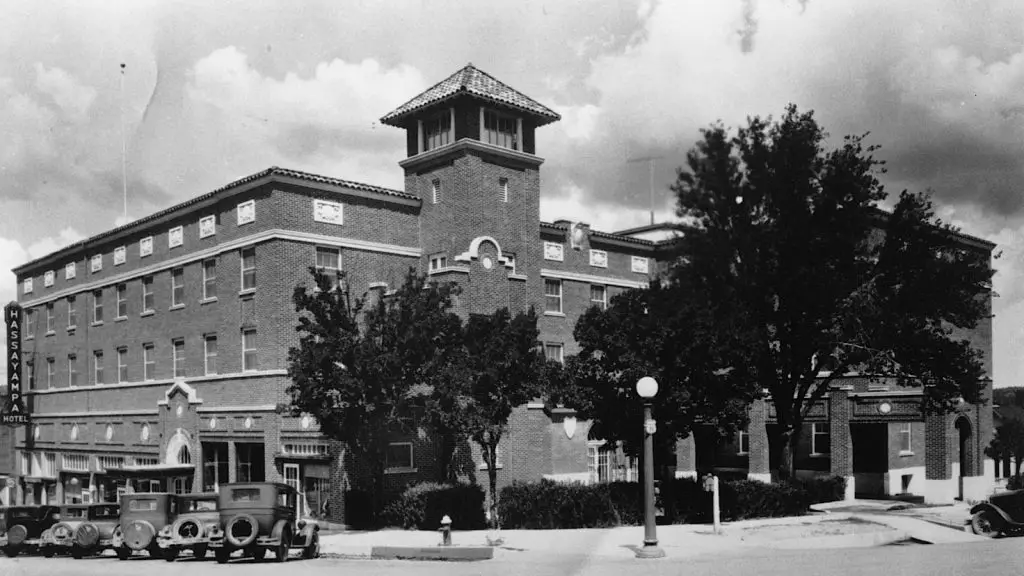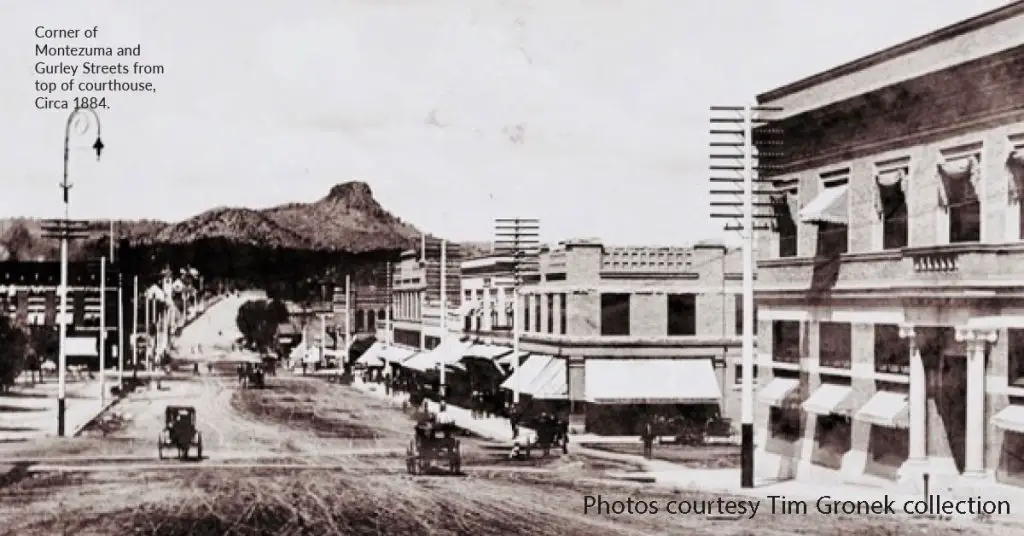Prescott, Arizona, is a city that has lived through an intriguing architectural evolution. This journey, mirroring the changing times and tastes, has painted a unique landscape that stands as a testament to Prescott’s rich history.

This article takes you through a photographic journey of Prescott’s architectural history, tracing the city’s transformation from its early days to the present.
Prescott’s Architectural Timeline: An Overview
Prescott’s architectural timeline is a colorful palette of styles, periods, and design philosophies. From the Victorian era that laid the city’s foundational aesthetics to the contemporary styles of the present day, each phase of Prescott’s architectural journey tells a unique story.
The Prescott Historical Society has meticulously chronicled this journey, offering a wealth of information and a treasure trove of photographs for anyone interested in learning more about the city’s architectural heritage.
The Early Period: Adobe Structures and Log Cabins
Prescott’s early architectural journey was defined by adobe structures and log cabins. Functional and simple, these buildings reflected the need for quick and efficient construction in a burgeoning frontier town. These humble structures laid the groundwork for the city’s future architectural landscape.
According to the Preservation of Arizona’s Resources and Cultural Environment (PARE), adobe and log cabin structures were commonly used by the early settlers in Prescott, demonstrating their resourcefulness and resilience in a harsh frontier environment.
Victorian Period: A Touch of Grandeur
The Victorian period, a reflection of Prescott’s growth and prosperity, introduced grand and ornate structures to the cityscape. This architectural style, characterized by its intricate design elements and elaborate ornamentation, gave Prescott a distinct identity.
As the Prescott Architecture Guide illustrates, Victorian architecture played a significant role in shaping Prescott’s built environment during the late 19th and early 20th centuries, reflecting the city’s newfound wealth and cultural sophistication.
Bungalow/Craftsman Era: Simplicity and Functionality
As the city stepped into the 20th century, Prescott saw a shift towards the Craftsman style, marked by simplicity, functionality, and an emphasis on natural materials. This architectural trend mirrored the changing societal values, with a focus on comfort, practicality, and harmony with nature.
The Craftsman Perspective, an online resource dedicated to Craftsman architecture, provides insightful information about this style and its significance in shaping Prescott’s early 20th-century cityscape.
Ranch Style Boom: A Suburban Revolution
In the post-World War II era, the Ranch style emerged as the face of suburban Prescott, characterized by its low, horizontal layout and emphasis on indoor-outdoor living. This architectural style reflected the city’s growth, technological advancements, and changing lifestyles.
A report by the National Trust for Historic Preservation highlights the popularity of the Ranch style in Prescott during the mid-20th century, noting its influence on the city’s suburban development.
Modern and Contemporary Architecture: Innovation Meets Tradition
The late 20th and 21st centuries saw the emergence of Modern and Contemporary architectural styles in Prescott. Marked by clean lines, innovative use of materials, and a balance between aesthetics and function, these styles added a fresh dimension to Prescott’s architectural landscape.
The Architecture Foundation of Prescott provides a detailed exploration of these modern architectural trends, underscoring their role in shaping Prescott’s present and future cityscape.
Prescott’s Iconic Buildings
The story of Prescott’s architectural history is best told through its iconic structures. Imbued with historical, cultural, and aesthetic significance, these buildings stand as visual markers of the city’s evolution.
From the majestic Hassayampa Inn to the timeless charm of the Courthouse Plaza, each edifice has its own tale to tell, its own contribution to the city’s architectural legacy.
These architectural landmarks not only symbolize the city’s past but also form an intrinsic part of its present. They are not just historical artifacts to be admired from afar; they continue to serve the community, be it as a public office, a commercial establishment, or a residential space.
Their continued relevance underscores the timeless nature of Prescott’s architectural heritage.
Historic Hassayampa Inn: A Victorian Masterpiece
The Hassayampa Inn, a cherished symbol of Prescott’s architectural past, has an aura of timeless elegance. Built in the 1920s during Prescott’s economic boom, it was designed to be a luxurious getaway for the city’s elite.
With its distinctive Victorian architecture, featuring a red-brick façade, intricate woodwork, and a grand lobby, the Hassayampa Inn stands as a testament to the city’s prosperous past.
But the Hassayampa Inn is not just a relic from the past. Today, it operates as a modern hotel, offering guests a unique blend of historic charm and contemporary comfort. Its continued operation underscores the enduring appeal of Prescott’s historic architecture and the city’s commitment to preserving its architectural heritage.
Courthouse Plaza: The Architectural Crown of Prescott
The Courthouse Plaza, with its imposing neoclassical design, is another iconic structure that features prominently in Prescott’s architectural history. Its granite structure, domed roof, and Corinthian columns exude grandeur and authority, making it a fitting centerpiece for the city.

The Courthouse Plaza is more than just a government building. It is a community space, a gathering point, and a symbol of civic pride. Its expansive grounds host numerous community events, from art fairs to Christmas celebrations, underscoring its importance in the city’s social and cultural life.
Preservation Efforts in Prescott
Preservation plays a crucial role in keeping Prescott’s architectural history alive. Recognizing the historical and cultural value of its built environment, the city has undertaken significant efforts to conserve its iconic structures.
From restoring dilapidated buildings to their former glory to adaptively reusing structures for modern purposes, these initiatives have helped to retain the city’s historic charm while accommodating its growing needs.
Preservation Arizona, a leading organization dedicated to protecting Arizona’s architectural heritage, highlights the city’s commitment to conservation and restoration. It underscores the various ways in which preservation efforts have contributed to the city’s economic and social vitality, such as boosting local businesses and enhancing community pride.
The Importance of Preservation in Architectural History
The importance of architectural preservation cannot be overstated. It is the key to safeguarding a city’s historical and cultural identity, as embodied in its built environment. In the context of Prescott, a city with a rich architectural legacy, preservation serves as a crucial link between its past and future.
Prescott’s preservation initiatives, therefore, serve a dual purpose. On the one hand, they ensure that historic buildings, each with its own architectural merit and historical significance, are not lost to time or redevelopment.
On the other, they facilitate the adaptive reuse of these structures, allowing them to serve modern purposes while retaining their historic character. This balance between conservation and adaptation is at the heart of Prescott’s approach to architectural preservation.
The National Trust for Historic Preservation underscores the importance of such initiatives, noting how they can create a sense of community, promote sustainable development, and enable cities like Prescott to maintain a tangible connection to their past.
Prescott’s Architectural Future
As Prescott continues to grow and evolve, its architectural landscape is set to undergo further transformation. This poses both challenges and opportunities for the city. On the one hand, accommodating growth while preserving historic charm is a delicate balance to strike.
On the other hand, it opens up avenues for innovation and creativity in design, enabling Prescott to carve out a unique architectural identity that bridges the past and the future.

The Urban Land Institute, an organization focused on responsible land use and creating thriving communities, offers insights on how cities like Prescott can balance growth and preservation. This includes incorporating sustainable design principles, leveraging technology, and promoting community engagement in urban development.
Sustainable Architecture: The Way Forward
Sustainability is likely to be a key driver of Prescott’s architectural future. From energy-efficient designs to the use of renewable materials, sustainable architecture can offer solutions that are both environmentally friendly and aesthetically pleasing.
The American Institute of Architects, a leading professional organization for architects, provides guidelines and resources for sustainable design. As these practices gain traction, they are likely to influence the city’s architectural development, shaping the next chapter of Prescott’s architectural journey.
Community Engagement in Architectural Development
Community engagement is another important aspect of Prescott’s architectural future. By involving residents in planning and design processes, the city can ensure that its architectural evolution aligns with the needs and values of the community.
The Project for Public Spaces, a nonprofit organization dedicated to creating and sustaining public spaces, offers resources on how community engagement can be integrated into urban development. These practices not only make cities more livable but also strengthen the bond between residents and their built environment.
FAQ:
In this section, we will be delving into some of the most common inquiries and curiosities that surround our topic.
What are some of the main architectural styles in Prescott?
Prescott’s architectural history features a variety of styles, including adobe and log cabin structures, Victorian, Craftsman, Ranch, and Modern/Contemporary architecture.
How has Prescott’s architecture evolved over time?
Prescott’s architecture has evolved alongside the city’s growth and development, reflecting changing societal values, technological advancements, and cultural influences.
What efforts are being made to preserve Prescott’s architectural history?
Prescott has undertaken significant preservation efforts, including the restoration of historic buildings and their adaptive reuse for modern purposes.
What is the future of architecture in Prescott?
The future of architecture in Prescott is likely to be influenced by sustainable design principles, technological innovations, and community engagement in urban development.
Conclusion
Prescott’s architectural history is a captivating tale of change and continuity, reflecting the city’s evolution from a frontier town to a vibrant city. As we look to the future, it’s clear that this architectural journey is far from over.
Each new phase of growth, each new architectural trend, will add a fresh layer to the city’s built environment, making Prescott’s architectural landscape an ever-evolving tapestry of styles and stories. As we admire the city’s architectural past, we can look forward with anticipation to the architectural marvels that the future holds.



Leave a Comment
You must be logged in to post a comment.